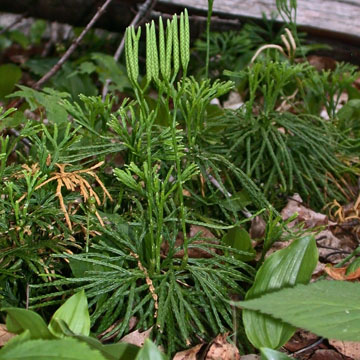

Diphasiastrum complanatum - (image 1 of 5)
Taxonomy
Family: Lycopodiaceae
Habitat
Acid soil in woods and on rocky slopes.
Associates
Distribution
Circumboreal, south in North America to northern New England, north central NY, northern MI, northern WI, northern MN, ID, and WA.
Morphology
Low evergreen from horizontal stems on the surface or just below soil level. Upright shoots, flattened, irregularly branched, without annual constrictions. Leaves green, shiny, 4-ranked, upper leaves appressed, lateral leaves partially free with a spreading or incurved tip. Strobili 1-2(-4), up to 3.2 cm long, terminal, blunt at the apex, sterile tips lacking; stalks forked at uniform distances.
Notes
Spores produced August to September
Wetland indicator: FAC
Diphasiastrum digitatum was once considered a variety of this species and lacks the annual constrictions on the branchlets.
References
Gleason, Henry A.
and A. Cronquist. 1991. Manual of Vascular Plants of Northeastern United States
and Adjacent Canada. Second Ed.
The New York Botanical Garden. Bronx, NY.
USDA, NRCS. 2002. The PLANTS Database, Version 3.5 (http://plants.usda.gov).
National Plant Data Center, Baton Rouge, LA 70874-4490 USA.
Wagner, W.H. Jr. and Beitel, J.M. 1993. Lycopodiaceae. In: Flora of North America North of Mexico, Vol. 2.
Oxford University Press, New York and Oxford.
|
Michael Hough © 2018 |